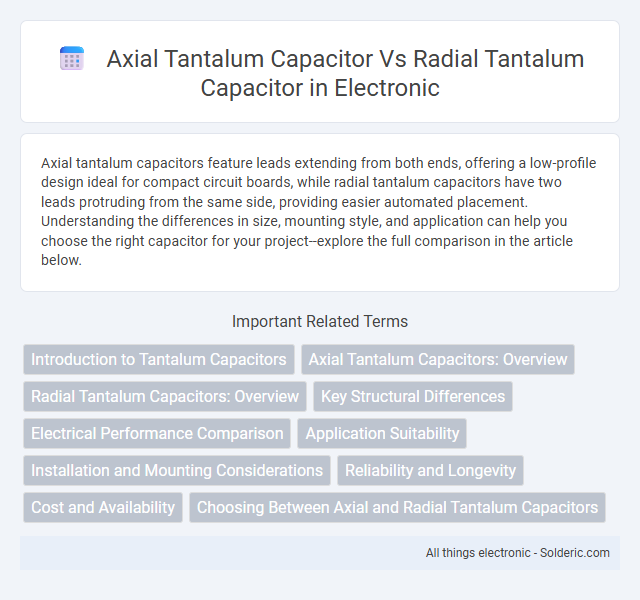Axial tantalum capacitors feature leads extending from both ends, offering a low-profile design ideal for compact circuit boards, while radial tantalum capacitors have two leads protruding from the same side, providing easier automated placement. Understanding the differences in size, mounting style, and application can help you choose the right capacitor for your project--explore the full comparison in the article below.
Comparison Table
| Feature | Axial Tantalum Capacitor | Radial Tantalum Capacitor |
|---|---|---|
| Lead Orientation | Leads extend from opposite ends (axial direction) | Leads extend from the same side (radial direction) |
| Mounting Style | Through-hole, suited for linear board placement | Through-hole, suited for compact board layouts |
| Size and Shape | Long, cylindrical shape | Shorter, compact cylindrical shape |
| Applications | Spaces requiring high voltage and stability over longer leads | Compact electronics, high-density PCB designs |
| Capacity Range | Typically 1 uF to 470 uF | Typically 0.1 uF to 100 uF |
| Voltage Rating | High voltage ratings, often up to 50V or more | Moderate voltage ratings, generally up to 35V |
| Cost | Generally higher due to larger size and materials | More cost-effective for lower capacitance needs |
| Reliability | High reliability in high-stress environments | Good reliability, optimized for space efficiency |
Introduction to Tantalum Capacitors
Tantalum capacitors, available in axial and radial lead configurations, are known for their high capacitance-to-volume ratio and reliability in electronic circuits. Axial tantalum capacitors feature leads extending from both ends along the component's axis, making them suitable for through-hole mounting in compact spaces. Radial tantalum capacitors have leads protruding from one side, offering easier automatic insertion and efficient PCB layout for high-density assemblies.
Axial Tantalum Capacitors: Overview
Axial tantalum capacitors feature leads that extend from both ends of the cylindrical body, enabling easy mounting in tight, linear spaces on circuit boards. These capacitors offer stable capacitance values, high volumetric efficiency, and excellent frequency characteristics, making them ideal for applications requiring reliable performance under high-temperature conditions. Their design supports low equivalent series resistance (ESR) and long operational life, which is critical in aerospace, military, and industrial electronics.
Radial Tantalum Capacitors: Overview
Radial tantalum capacitors feature leads extending from one end of the cylindrical body, making them ideal for compact circuit boards where vertical space is limited. These capacitors offer excellent capacitance stability, low equivalent series resistance (ESR), and high volumetric efficiency, commonly used in power supply filtering and decoupling applications. Their straightforward mounting process and reliable performance under high temperature and ripple current conditions make them a preferred choice in modern electronic designs.
Key Structural Differences
Axial tantalum capacitors feature leads extending from opposite ends of the cylindrical body, allowing streamlined installation in linear circuit arrangements. Radial tantalum capacitors have both leads protruding from the same side, enabling compact vertical mounting on PCBs. The structural orientation impacts board space efficiency and ease of automated assembly in electronic designs.
Electrical Performance Comparison
Axial tantalum capacitors generally exhibit lower equivalent series resistance (ESR) and better high-frequency performance compared to radial tantalum capacitors, making them suitable for applications requiring stable electrical characteristics under dynamic loads. Radial tantalum capacitors typically offer higher capacitance values in compact footprints but may present slightly higher ESR and less optimal ripple current capabilities. Electrical performance differences stem from lead configuration and internal construction, influencing parameters such as impedance and ripple current tolerance.
Application Suitability
Axial tantalum capacitors are ideal for applications requiring compact, low-profile components along a linear circuit path, such as in space-constrained electronic devices and medical equipment. Radial tantalum capacitors offer better mechanical stability and are suited for high-vibration environments like automotive electronics and industrial machinery. Selecting between axial and radial types depends on the device layout, available space, and environmental stress factors for optimal performance and reliability.
Installation and Mounting Considerations
Axial tantalum capacitors feature leads extending from both ends, allowing them to lie flat against the PCB, which is ideal for compact, low-profile installations requiring secure mounting. Radial tantalum capacitors have two leads emerging from one end, enabling vertical mounting that reduces PCB footprint and simplifies automated assembly processes. Selection between axial and radial capacitors depends on the specific PCB layout, space constraints, and the preferred soldering technique, such as through-hole or wave soldering.
Reliability and Longevity
Axial tantalum capacitors generally offer enhanced mechanical stability, reducing stress on the leads and improving reliability in high-vibration environments compared to radial tantalum capacitors. Radial tantalum capacitors tend to have a smaller footprint, but their lead arrangement may increase the risk of mechanical fatigue, potentially impacting longevity under harsh conditions. Reliability and longevity of both types heavily depend on proper derating and operating conditions, with axial capacitors preferred in applications demanding superior durability.
Cost and Availability
Axial tantalum capacitors typically have a higher manufacturing cost due to their complex lead configuration, which results in less widespread availability compared to radial tantalum capacitors. Radial tantalum capacitors are more cost-effective and commonly stocked by suppliers, making them easier to source for most electronic applications. When selecting components for your project, considering the balance between budget constraints and availability is crucial for timely procurement and cost management.
Choosing Between Axial and Radial Tantalum Capacitors
Axial tantalum capacitors feature leads extending from both ends, ideal for through-hole mounting with low profile requirements, while radial tantalum capacitors have two leads emerging from one side, offering compact footprints suited for high-density circuit boards. Your choice depends on board layout constraints and mechanical stress considerations, as axial types handle bending better and radial types support automated assembly processes. Evaluating your application's size, insertion methods, and reliability needs ensures optimal capacitor performance and longevity.
axial tantalum capacitor vs radial tantalum capacitor Infographic

 solderic.com
solderic.com